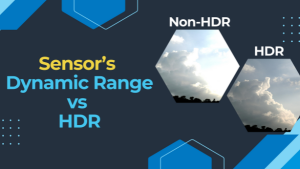
Image Sensor Dynamic Range vs. High Dynamic Range – Key Differences
The terms image sensor’s “dynamic range” and “high dynamic range (HDR)” are related concepts in the field of digital imaging, but they refer to different aspects:
Image Sensor Dynamic Range
- The dynamic range of an image sensor refers to its ability to capture and represent the range of light intensities in a scene, from the darkest shadows to the brightest highlights.
- It is typically measured in terms of the ratio between the maximum and minimum detectable light intensities, often expressed in decibels (dB) or stops.
- A higher dynamic range means the sensor can capture a broader range of light levels without losing detail in either the shadows or highlights.
- Image sensor dynamic range is a characteristic inherent to the sensor itself and is influenced by factors such as pixel size, sensor size, and sensor technology (e.g., CMOS vs. CCD).

Figure 1: Standard Dynamic Range Sensor (Left) and Good Dynamic Range Sensor (Right)
High Dynamic Range (HDR):
- HDR, on the other hand, refers to a technique used in photography and digital imaging to reproduce a greater dynamic range than what is typically possible with standard imaging techniques.
- In HDR imaging, multiple images of the same scene are captured at different exposure levels, ranging from underexposed to overexposed.
- These images are then merged or processed using specialized software to create a single composite image that preserves details in both the shadows and highlights.
- The resulting HDR image typically exhibits greater contrast and detail than a single exposure image, making it visually appealing and more closely resembling the dynamic range of the human eye.
- HDR imaging can be achieved through techniques such as exposure bracketing, tone mapping, and blending multiple exposures.

Figure 2: HDR (Left) and Non–HDR (Right)
